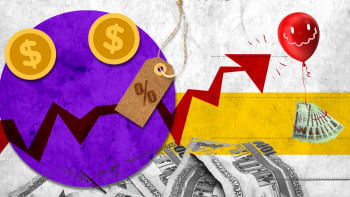Surging government borrowing portrays a grim future

Government borrowing from the banking sector has been rising alarmingly since the end of the pandemic. The government took around Tk 98,000 crore in loans from Bangladesh Bank in the 2022-23 fiscal year – which was 44 percent of the total deficit, suggesting excessive borrowing. Borrowing is used to plug the budget deficit, but enough acumen on economics and finance must be exercised to decide the sources of borrowing since different sources can lead to different repercussions on growth and the economic future. Recent trends seem to care too little about the wise art of deficit financing.
Since we are sure that the FY2024 budget is not headed in a good direction – because of its underestimation of inflation and overestimation of growth – let us take the revised budget of FY2023 as an example to visualise the ever-growing fiscal anaemia. Just 10 years ago under the same regime, the FY 2013 budget displayed its deficit as 23 percent of the budget, according to calculations derived from official figures, suggesting that the government managed Tk 77 when the budget was assumed to be Tk 100. The fiscal capacity of that magnitude was not too bad, though the government then vowed to increase its revenue capacity every year ahead. Ten years later, the budget eventually delivered a picture of the dwindling fiscal capacity. A budget of Tk 100 in FY2023 required deficit financing for Tk 34 while it should have been below the 23 percent that was possible a decade ago.
If this trend of chronic fiscal incapacity continues, a 10-year projection from now would land the nation at a budget deficit of around Tk 44 or so out of Tk 100 – which will be disastrous if the government's taxing capacity cannot be rescued from the disease of pampering the super-rich. Not displeasing the oligarchs and tycoons by imposing progressive tax rates on them lies at the root of the gradual collapse in our fiscal capacity, whose pernicious impact has been pushing the banking sector from bad to worse. And the finance sector is heading to an unsustainable state thereby depicting a grim future for the nation.
While borrowing from other commercial banks will create crowding out effects by depriving the private sector from availing loans, borrowing from the central bank is a double-edged sword for stoking inflation and promoting further fiscal incapacity. The stubbornly high inflation at double digits, and the government's increased fiscal borrowing over the post-pandemic years, are bitter testimonies to the claim that a bleak future for the economy looms on the horizon unless the finance ministry pulls the bridle of the fiscal spending and accelerates its capacity to increase the amount and base for tax collection. The government should consider building a separate ministry for the entire revenue collection system since the finance ministry shows no improvements regarding expected tax collection.
Just 10 years ago under the same regime, the FY 2013 budget displayed its deficit as 23 percent of the budget, according to calculations derived from official figures, suggesting that the government managed Tk 77 when the budget was assumed to be Tk 100. The fiscal capacity of that magnitude was not too bad, though the government then vowed to increase its revenue capacity every year ahead. Ten years later, the budget eventually delivered a picture of the dwindling fiscal capacity. A budget of Tk 100 in FY2023 required deficit financing for Tk 34 while it should have been below the 23 percent that was possible a decade ago.
The FY2013 budget occupied 18.24 percent of GDP while the government was able to manage 14 percent of GDP as revenue. The FY2023 budget captured an even lower share of GDP, only 14.9 percent, while the government's revenue management reached another low at 9.9 percent. The revenue-to-GDP ratio should naturally step up as an economy moves up on the development ladder. Of course, the economy is developing but the super-rich are not contributing the fair share of their increased capacity to the public coffers simply because the tycoons can make public institutions act in their favour and eschew paying appropriate taxes in order to balloon their fortunes.
This kind of symbiotic relationship between the affluent and the regime is perilous for the future of the economy. And the relationship has recently turned into hyperactive endorsements from both sides as the election bell rings. The FY2024 budget projects to increase the revenue-to-GDP ratio to over 20 percent in the future. No matter how farcical that kind of utterance is, the ministry did not give any timeline, implying the vagueness of the statement. In contrast, take, for example, the growing economy of Vietnam where the average revenue-to-GDP ratio from 2020 to 2022 has remained above 15 percent.
In Bangladesh, 63 percent of the fiscal deficit of the FY2023 budget was financed from domestic sources, and the remaining 37 percent from foreign counterparts. The banking sector alone gave 52 percent of the fiscal deficit while the amount borrowed from the central bank was as high as 44 percent. The "beauty" of borrowing from the central bank is that eventually the government does not pay anything for the interest burden because the central bank's income is ultimately the government's earnings. That is why most emerging governments prevent this damaging practice from happening by imposing a law against this kind of easy debt monetisation. India passed the Fiscal Responsibility and Budget Management Act, 2003 to stop automatic monetisation of the fiscal debt. Bangladesh requires a similar act to check the current trend of fiscal trespassing into the territory of the central bank.
The worst effect of the government's borrowing from the central bank surfaces through the high-octane pressures on inflation – different from that of other modes of financing. The central bank gives high-powered money to the government, and it has higher multiplier effects on money creation. Thus, borrowing from Sonali Bank versus Bangladesh Bank is fundamentally different in fuelling inflation. The magnitude is much higher once the government borrows money directly from the central bank. That is another reason why Bangladesh's inflation even in July 2023 remained over double digits, while the inflation rate for other comparable economies including India has dropped to almost half of ours.
The government's borrowing from the banking sector over FY2024 will be even higher, as predicted. The default loans will go up as the trend suggests. Businessmen will prepare excuses, citing political disruptions in the lead-up to the upcoming national election. The pressure from both the government and the habitual defaulters will squeeze the lending space for banks, making the cost of funds more expensive for small and medium-sized enterprises (SMEs). This will discourage investment, which will in turn impede GDP growth and growth in employment. The only rescue plan from this conundrum is to drastically enhance tax collection from business groups, noted tycoons, habitual defaulters, and doubted money launderers. There is no Plan B in this respect.
Dr. Birupaksha Paul is a professor of economics at the State University of New York at Cortland, USA.

 For all latest news, follow The Daily Star's Google News channel.
For all latest news, follow The Daily Star's Google News channel. 










Comments